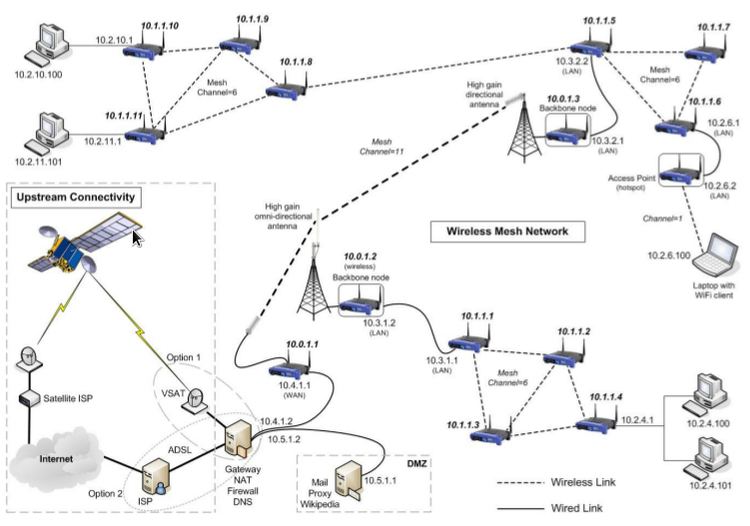 | ||
A wireless mesh network (WMN) is a communications network made up of radio nodes organized in a mesh topology. It is also a form of wireless ad hoc network. Wireless mesh networks often consist of mesh clients, mesh routers and gateways. The mesh clients are often laptops, cell phones and other wireless devices while the mesh routers forward traffic to and from the gateways which may, but need not, be connected to the Internet. The coverage area of the radio nodes working as a single network is sometimes called a mesh cloud. Access to this mesh cloud is dependent on the radio nodes working in harmony with each other to create a radio network. A mesh network is reliable and offers redundancy. When one node can no longer operate, the rest of the nodes can still communicate with each other, directly or through one or more intermediate nodes. Wireless mesh networks can self form and self heal. Wireless mesh networks can be implemented with various wireless technologies including 802.11, 802.15, 802.16, cellular technologies and need not be restricted to any one technology or protocol.
Contents
Architecture
Wireless mesh architecture is a first step towards providing cost effective and dynamic high-bandwidth networks over a specific coverage area. Wireless mesh infrastructure is, in effect, a network of routers minus the cabling between nodes. It's built of peer radio devices that don't have to be cabled to a wired port like traditional WLAN access points (AP) do. Mesh infrastructure carries data over large distances by splitting the distance into a series of short hops. Intermediate nodes not only boost the signal, but cooperatively pass data from point A to point B by making forwarding decisions based on their knowledge of the network, i.e. perform routing. Such an architecture may, with careful design, provide high bandwidth, spectral efficiency, and economic advantage over the coverage area.
Wireless mesh networks have a relatively stable topology except for the occasional failure of nodes or addition of new nodes. The path of traffic, being aggregated from a large number of end users, changes infrequently. Practically all the traffic in an infrastructure mesh network is either forwarded to or from a gateway, while in ad hoc networks or client mesh networks the traffic flows between arbitrary pairs of nodes.
Management
This type of infrastructure can be decentralized (with no central server) or centrally managed (with a central server). Both are relatively inexpensive, and can be very reliable and resilient, as each node needs only transmit as far as the next node. Nodes act as routers to transmit data from nearby nodes to peers that are too far away to reach in a single hop, resulting in a network that can span larger distances. The topology of a mesh network is also reliable, as each node is connected to several other nodes. If one node drops out of the network, due to hardware failure or any other reason, its neighbors can quickly find another route using a routing protocol.
Applications
Mesh networks may involve either fixed or mobile devices. The solutions are as diverse as communication needs, for example in difficult environments such as emergency situations, tunnels, oil rigs, battlefield surveillance, high-speed mobile-video applications on board public transport or real-time racing-car telemetry. An important possible application for wireless mesh networks is VoIP. By using a Quality of Service scheme, the wireless mesh may support local telephone calls to be routed through the mesh.
Some current applications:
Operation
The principle is similar to the way packets travel around the wired Internet – data will hop from one device to another until it eventually reaches its destination. Dynamic routing algorithms implemented in each device allow this to happen. To implement such dynamic routing protocols, each device needs to communicate routing information to other devices in the network. Each device then determines what to do with the data it receives – either pass it on to the next device or keep it, depending on the protocol. The routing algorithm used should attempt to always ensure that the data takes the most appropriate (fastest) route to its destination.
Multi-radio mesh
Multi-radio mesh refers to a unique pair of dedicated radios on each end of the link. This means there is a unique frequency used for each wireless hop and thus a dedicated CSMA collision domain. This is a true mesh link where you can achieve maximum performance without bandwidth degradation in the mesh and without adding latency. Thus voice and video applications work just as they would on a wired Ethernet network. In true 802.11 networks, there is no concept of a mesh. There are only APs and Stations. A multi-radio wireless mesh node will dedicate one of the radios to act as a station, and connect to a neighbor node AP radio.
Research topics
One of the more often cited papers on Wireless Mesh Networks identified the following areas as open research problems in 2005
Routing protocols
There are more than 70 competing schemes for routing packets across mesh networks. Some of these include:
The IEEE has developed a set of standards under the title 802.11s.
A less thorough list can be found at Ad hoc routing protocol list.
Autoconfiguration protocols
Standard autoconfiguration protocols, such as DHCP or IPv6 stateless autoconfiguration may be used over mesh networks.
Mesh network specific autoconfiguration protocols include:
